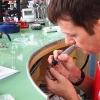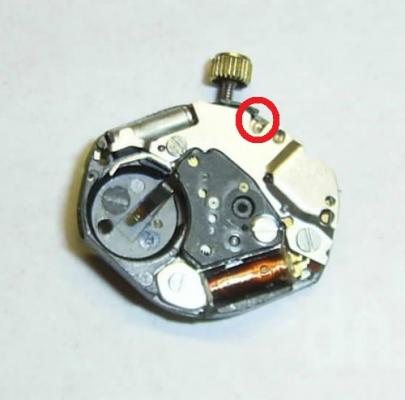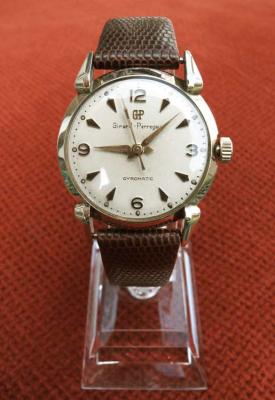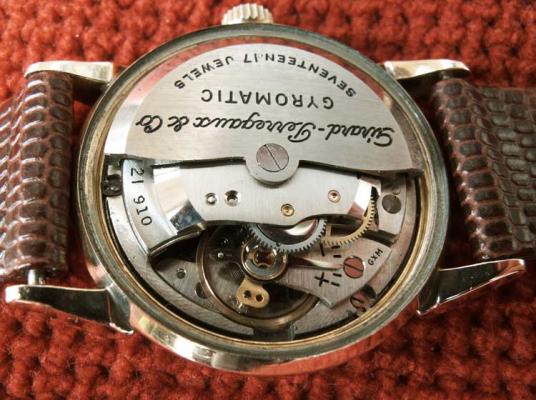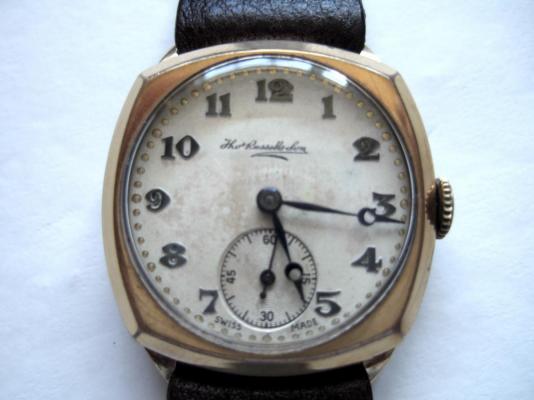Leaderboard
Popular Content
Showing content with the highest reputation on 07/29/14 in all areas
-
Have you studied the slow moving wheels in detail to see if there is any damage or something stuck between any of the leafs? Another thing worth checking is that the spring is OK and not slipping off the barrel hook. Just a thought!2 points
-
2 points
-
Hi SuzyQ and welcome to the forum. Sometimes the stems are quite stiff to operate. I would suggest that you use a small pair of narrow nose pliers to push the stem up and down from the running position to the setting position. When you do this look in the small hole to the right of the letters AL 12c and in either the setting position or running position a small lever with a dimple in it should appear. When it does, press it and the stem should come out. If that doesn't work, check other places, but remember that you will have to have the stem in the correct position to operate the release.2 points
-
I didn't realise haw attracted I am to lugs until I saw this watch. It's my latest find on the Bay and it turned out to be a real beauty, even though the watch was badly photographed and the description poorly written. I just about gave it a miss as I thought it was a Peregaux fake. It arrived from LA yesterday and i could hardly believe how good it is for a nearly sixty year old watch. All that was required was a wipe with a silver cleaning cloth and the 10kt gold plate came up like new. There are no marks to speak of on either the metal or the crystal and it is curently running at about -15 seconds a day. The movement looks like it has never seen a screwdriver since it left the factory. At 31mm it is the smallest watch in my collection, but I just love it.1 point
-
Thank you guys, I'm not too good at explaining! Great support! I wonder where Lee gets all the pictures! Amazing! By the way Lee, I'm always visiting your blog, nice and to the point. Thank you for having it. SusyQ, with all this help you have to have that stem out for sure! Tell us about your progress and please don't hesitate to ask away! It is a beautiful hobby.1 point
-
Overkill?? Never! Back in the day I would use a bit of clean business card to clean the ignition contacts and relay contacts to a polished finish, just because.1 point
-
1 point
-
Excellent Rossco, keep up the good work! Let us know how the maple sticks work for you. Maybe that would be a better solution than the plastic sticks they sell out there. One word of caution, remember wood may leave small pieces in the watch so always use a puff of air when you are done and check it out with magnification. I wonder if a stick made of brass could be a good idea... Robert.1 point
-
In this case, I would agree that its mainly aesthetic. In other cases it may allow for oiling of pivots which may otherwise be covered, worth checking ! Anil1 point
-
I think SuzyQ that it is more a hole or even the tip of a lever than a dimple (although dimple could work too) and you have to stick one leg of the tweezers in, gently and push. You will feel you are pushing something (springlike) down. At the same time the stem will become loose at your pull of it (it will detach). If that little end or bright point in the front left of the stem doesn't give, try another hole alonside the stem, gently, but look carefully first before you damage anything.1 point
-
Is there an arrow or some indication next to the stem to the left front or is it simply the movement information? How about to the right between the stem and the battery? There is usually an indication about the right spot to stick the tweezers or a small sharp object to release the stem. On the other hand, it seems that you can still grab the stem by holding the portion of the crown still attached to it so the 2 tweezers trick might not be necessary. Remember to puch the release lever and pull the stem at the same time...kind of gently.1 point
-
Hi SuzyQ, Welcome to the forum. Help is on the way! And don't worry, all will be well. I understand your frustration but patience is all powerful when with watches! So, in those cases, I usually use 2 tweezers to pull the stem out. One to push the stem release lever (usually through a hole or a little "button") -- I believe the hole on the left of the stem in the picture but it is not too clear -- and the other tweezer to grab at the stem proper and pull. This pull is usually by parts since there is not much room for a full pull of the stem. You might even have to wriggle the tweezers side to side...Be careful since you are working inside the watch! In any case, that's what I do. Maybe other members have a better way of doing it? I hope some of this helps! One question from the picture, is that a portion of the crown still attached to the watch or just the tube where the stem fits in? Is part of the stem still in the crown where it broke? Robert1 point
-
Thanks for all your interest. Fortunately the amatuer only needs very small amounts of lubricant so just tell the other half its a cosmetic, like they buy at often very high prices!!! I thought I would broach the next aspect of lubricants, that being what is added to a base oil to make the various lubricants to cover a wide range of duties. So What Additives are used I will cover these in general terms as the chemisty can be quite daunting and even I have to 'phone a friend' on many occassions! Ok, additives are required to modify or enhance a base oils natural properties to meet the desired operating conditions. Generally, the more severe the operating conditions, or, the lower the quality or specification of the base oil, then the more additives are required. Lubricants for watches clearly do not need the same performance additives used in engine oils, extreme climatic conditions, and severe stress conditions to name few. Corrosion inhibitors - these are used as you would imagine to prevent rusting of iron/steels but also to prevent oxidation etc of non-ferrous metals (copper, bronze, aluminium, silver etc). Virtually every lubricating oil will have these to some degree. Anti-oxidants - these are to slow down the natural oxidation of the base oil which occurs over time and which can be accelerated by such things as sunlight, high temps, oxidising agents etc. Virtually all lubricants contain these additives, more so with ordinary mineral oils than synhtetic mineral oils (I'll call these shc oils (synthesised hydro-carbons) from now for simplicity. Oilness/Lubricity - these are often used to further reduce friction (ie more slipery) by modifying the surfaces of the lubricating surfaces. They can be chemical compounds but an old favourite is neats foot oil. Again these are more likely to be found in normal mineral oils as shc's have more inherent oilness/lubricity. Viscosity Improvers - These are basically long chain polymers (I know, chemistry again!) which will enable an oil to stay thicker as the operating temperature rises. They are widely used in engine oils (more commonly known as multigrading) and can be found in some high performance hydraulic oils. They are usually added to a 'thin' oil to increase viscosity. They will degrade (they get chopped -up basically) and so the 'multigrade' oil will slowly revert to the base monograde oil. Example a 5W/40 engine oil starts as a base oil meeting the 5W (w=winter!, 0degC) specification and is multigraded to meet the 40 (summer, 100C) specification, and will degrade to the 5W (ie it will be 5W/30, 5W/20 etc over time). Some mineral watch oils have these where they are required to operate in say artic or desert conditions. Pour Point Depressants - can be considered the oposite of viscosity improvers. They lower the point at which an oil becomes fluid. Fluidity is lost as the natural waxes in a mineral oil solidify ( a bit like the wrong diesel fuel in winter!!). They are normally only required if low operating conditions (arctic say), are likely or used for high viscosity oils. Not normally required in shc oils, and are more likely to be required if low quality base oils are used. Can be found in special purpose watch oils. Anti-Wear - These are used when the the layer of oil maybe getting a bit thin and a little extra protection in required and not to be confused with extreme pressure (EP) additives. These basically modify the surfaces to allow easier transitions (best described as adding a (carpet) pile to the surfaces). The most common of these is called ZDDP (Zinc Dialkyl Dithio Phosphate, more chemistry!!). Sometimes found in watch oils where a bit more oomph than straight oil is required. Extreme Pressure (EP) - these are added to handle matters when the oil film breaks down and metal to metal contact occures. If you look at a section of a surface under a microscope it looks like a craggy mountain range (less craggy the better the finish). Consider two of these ranges on top of each other peak-to-peak. When the peaks collide they try to weld together due to the very high temps (melting point of steel!). The EP additives are based on sulphur, phosphorous and sometimes chlorine compounds which will 'become fluid' at high temps and so provide the 'lubricating medium' and prevent welding. These additives only work when the above conditions occur, and will be inactive and not needed if this is unlikely to occur. Hence they are used in rubbing, sliding and high load conditions in a watch. Watch oils will not have anything like the additive level found in automotive/industrial applications. Highly potent types would probably cause severe staining of watch parts (so don't go to Halfords for it!!). Colour Dyes - do nothing for lubrication but can help identification and leak tracing. Mostly for fashion or branding statement!! The above are the most common types used in watch oils, a brief list of others shows how many others are used in industrial applications. Detergent/Surfactant - these are added to keep parts clean to avoid gumming etc. Normally found in engine oils and high temp applications. Have seen in watch oil but normally used in oil circulating systems. Dispersants - these are added to hold in suspension, the stuff removed by the detergent until it can be removed by a filter (not seen a watch with an oil filter yet!!). Wetting Agent - helps the oils to spread, definitely not for watches! Acid Neutralisers - engine combustions and severe oxidation produces acids, these help to neutralise these acids (sometimes call TBN improvers). Not needed for watch oils. Emulsifiers - make the oil soluble in water. Sometimes used in cooling systems where antifreeze is not required. Have their own set of problems and not used in watch oils. Stick/Slip - basically a special type of lubricity additive to reduce the effects of a surface holding onto a part until it suddenly goes. A bit like the effect desired of an autowinder mainspring action. Mainly used in workshops on machine beds. Solids - Moly, graphite etc. Normally used when normal lubrication cannot handle operating requirements, and are in suspension and normally plate-out on the component parts. Can reduce very tight tolerances to a detrimental level. Graphite will conduct electricity. Many of the above are also used in base oil for greases for the same reasons, the grease just holding the oil in place or reserve. As they are chemical compounds, as always there cab be a range of quality. Blenders will also have cost considerations re quality and quantity used in their oils. I am sure I have missed some, so if you have a particular bug, reply to my post and I'll try and help. Got to stop now (thats if your still awake!) as my fingers ache! Hope I haven't bored you too much. I'll cover what the 'numbers' mean later and also whats in the more popular watch oils and greases.1 point
-
What do you think the purpose of the cut-outs in the ratchet is? Just curious...1 point




